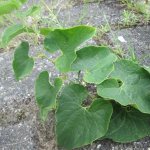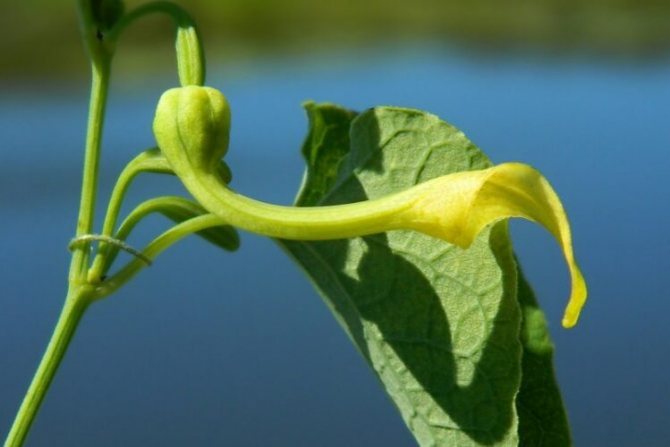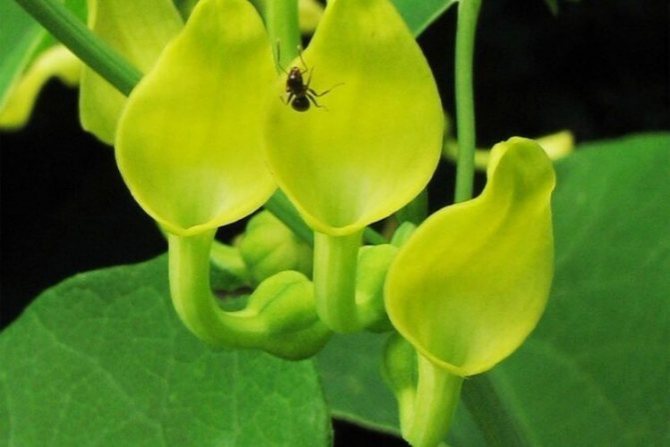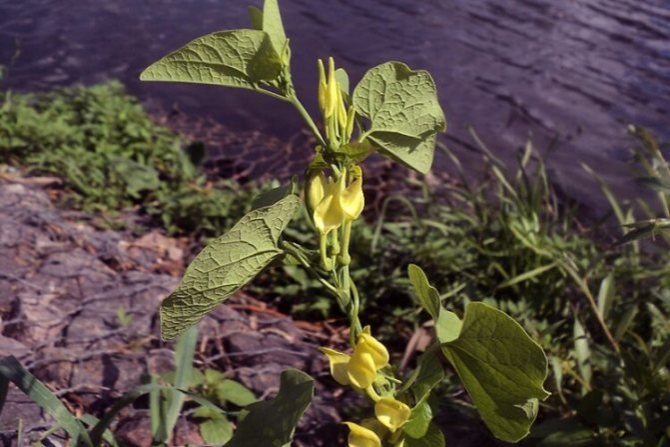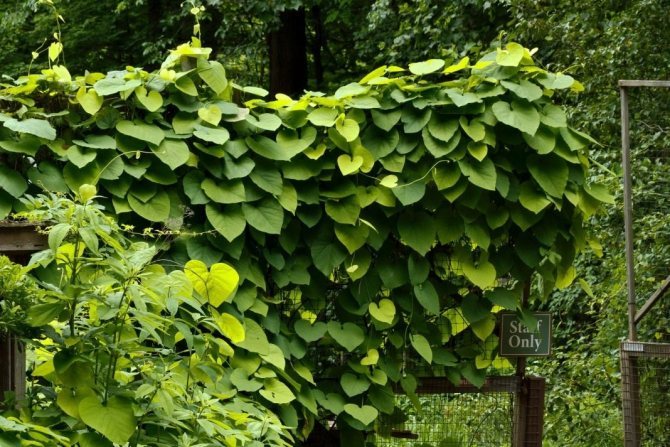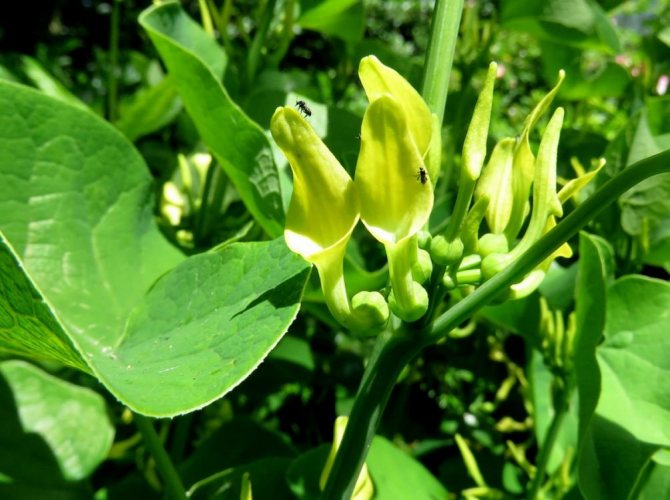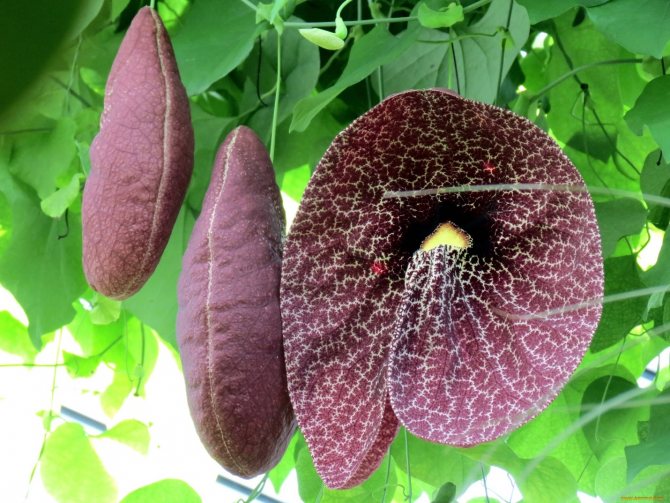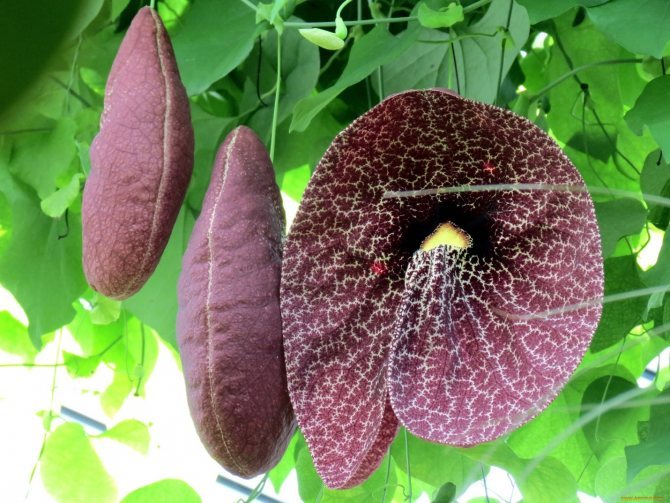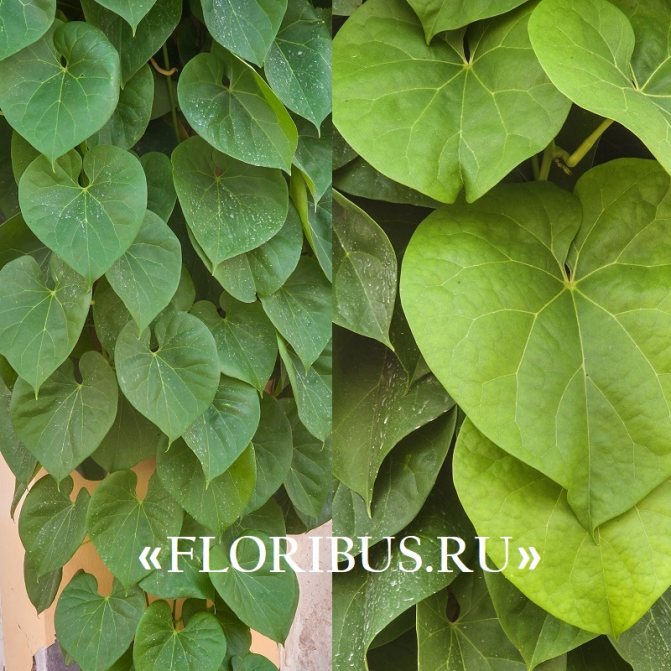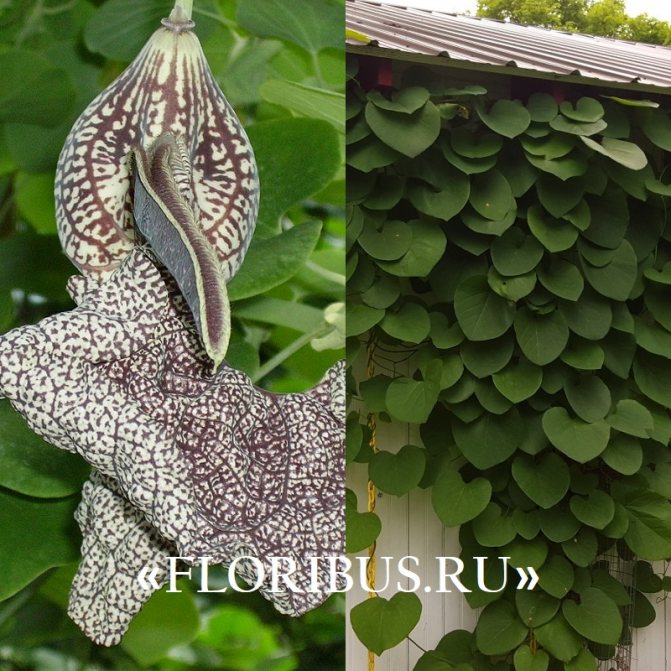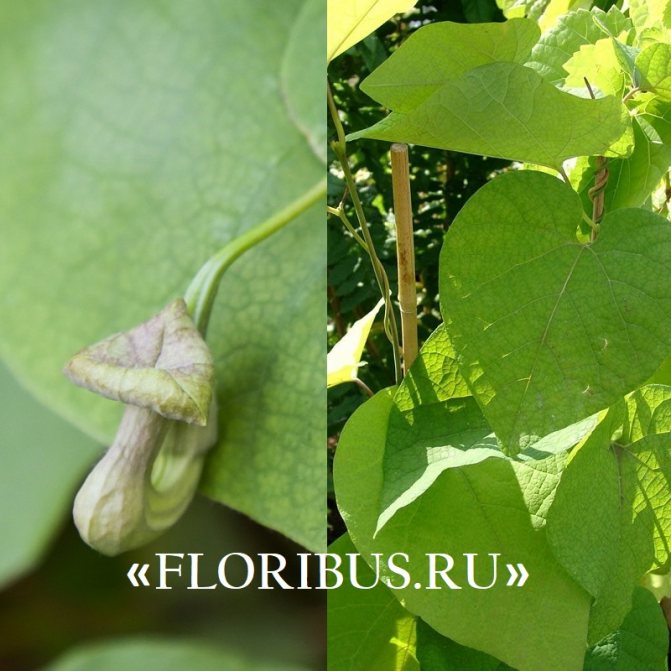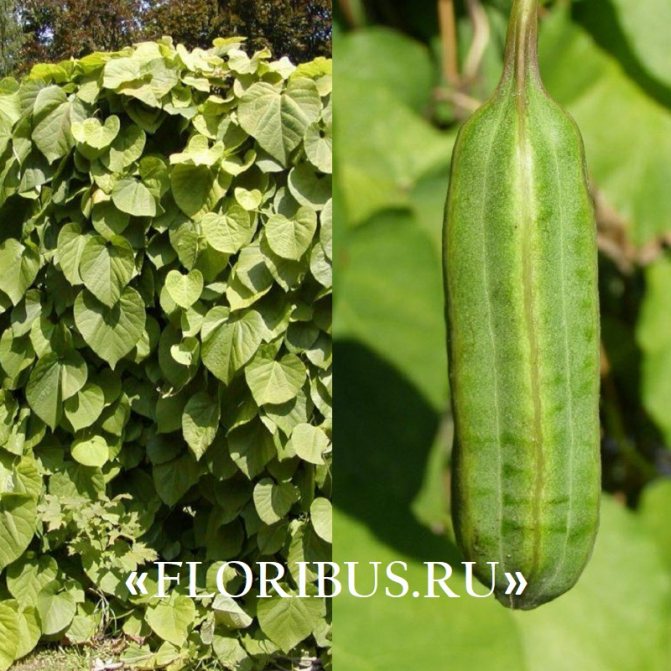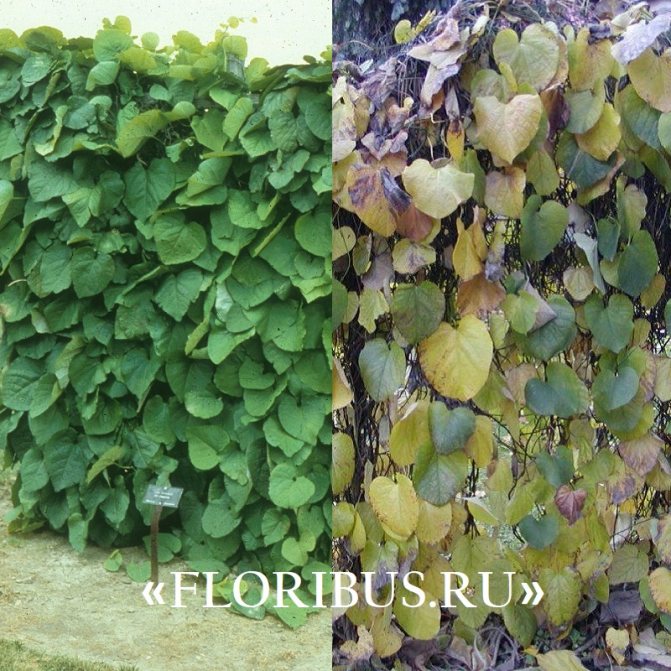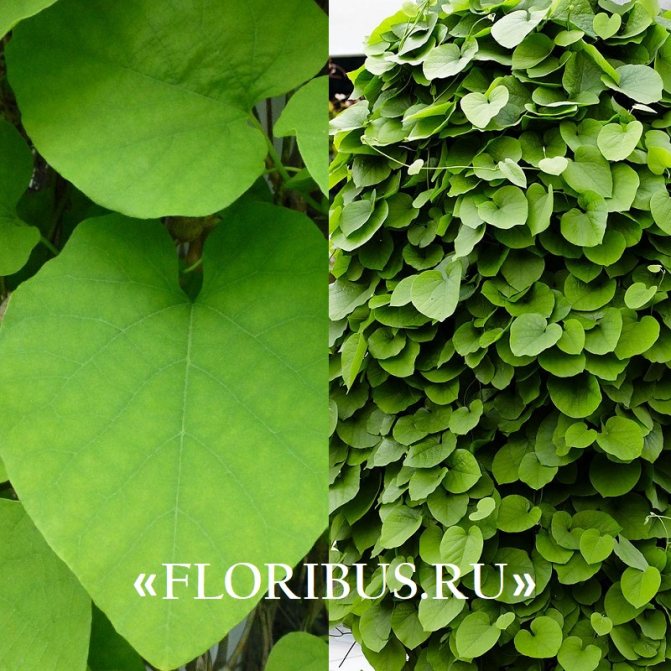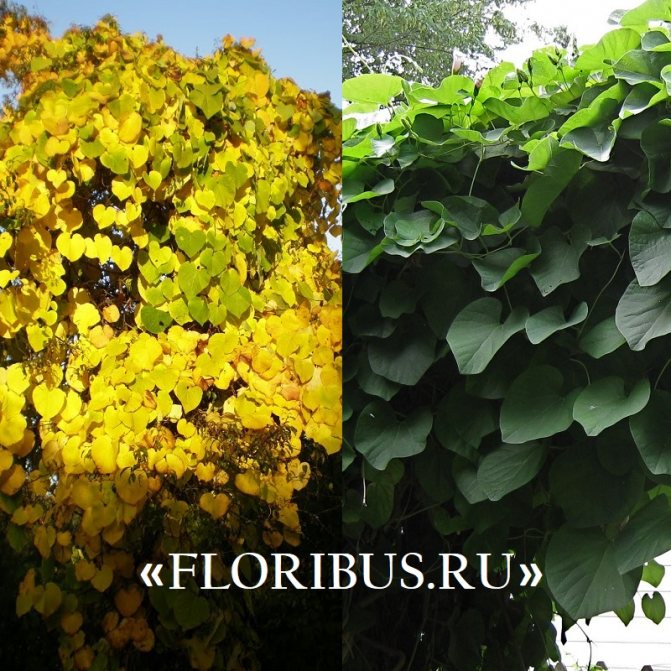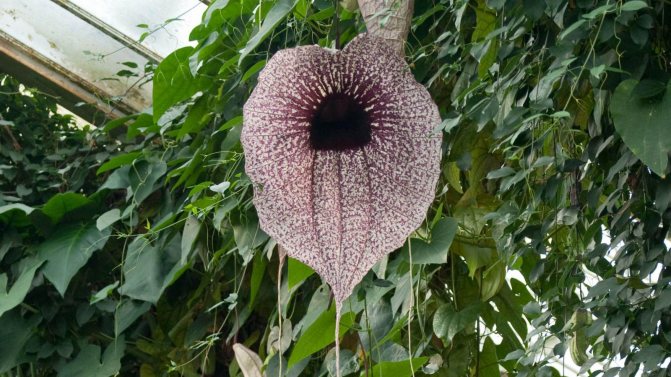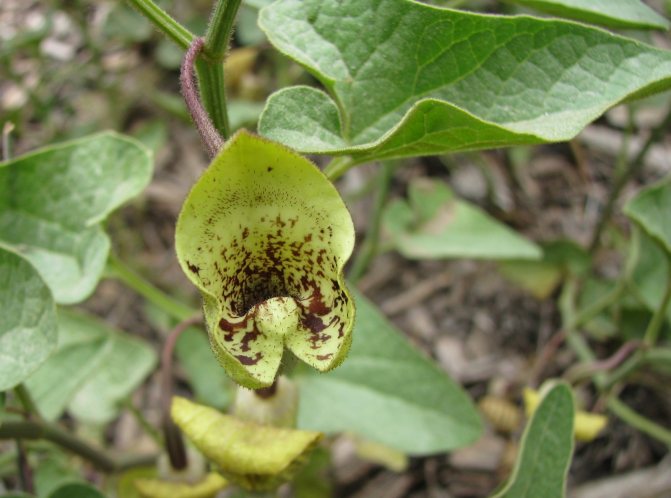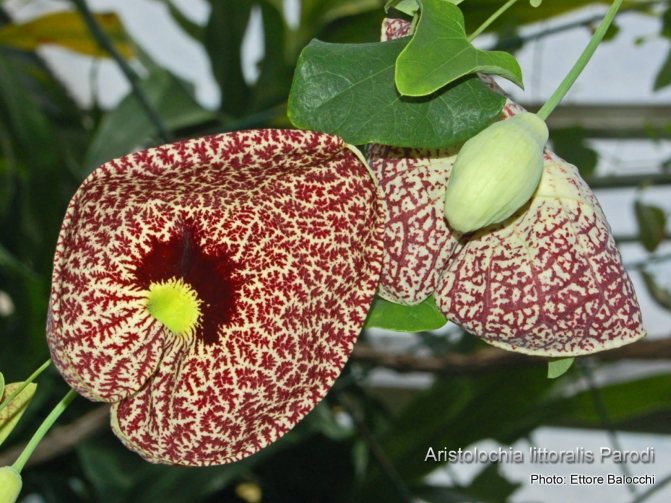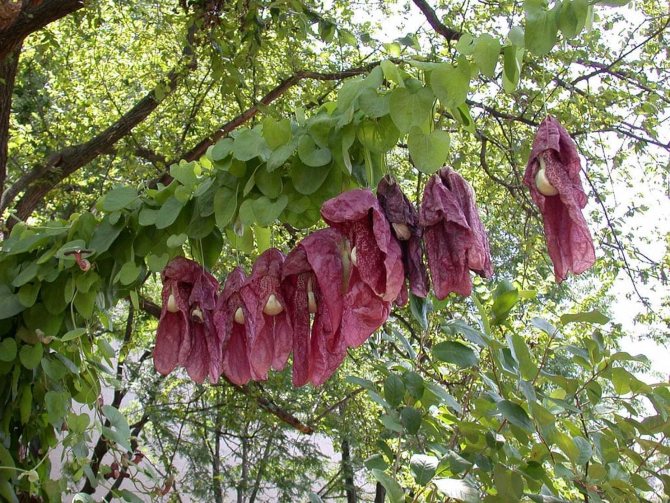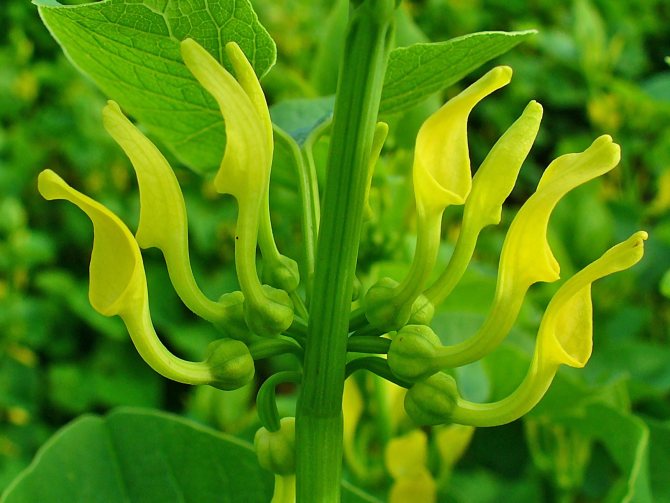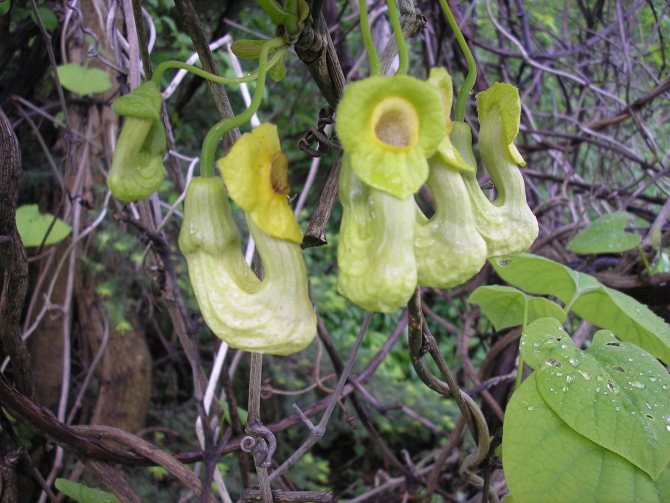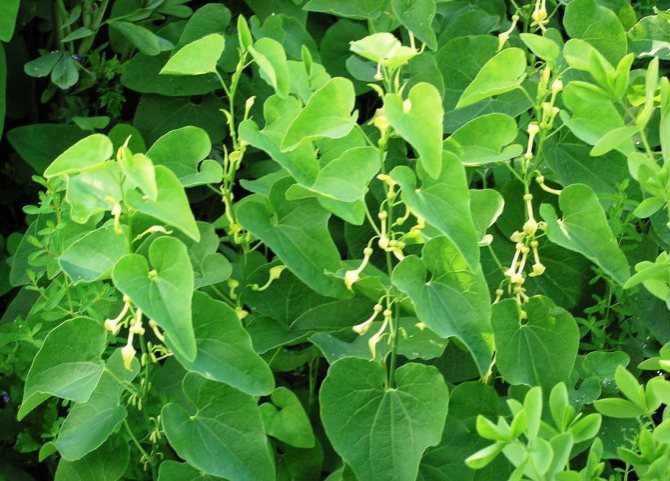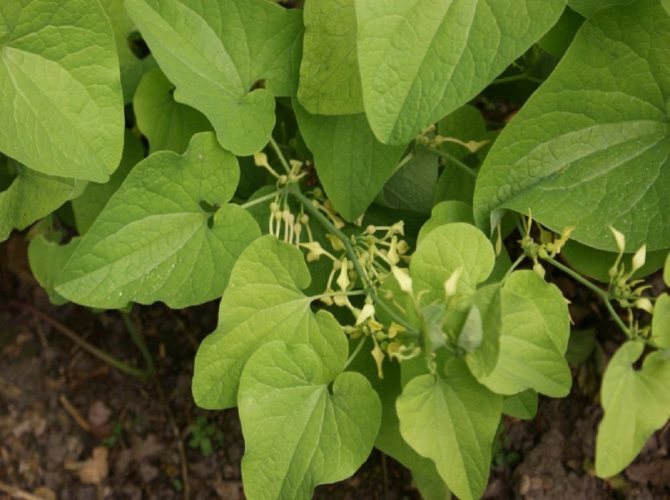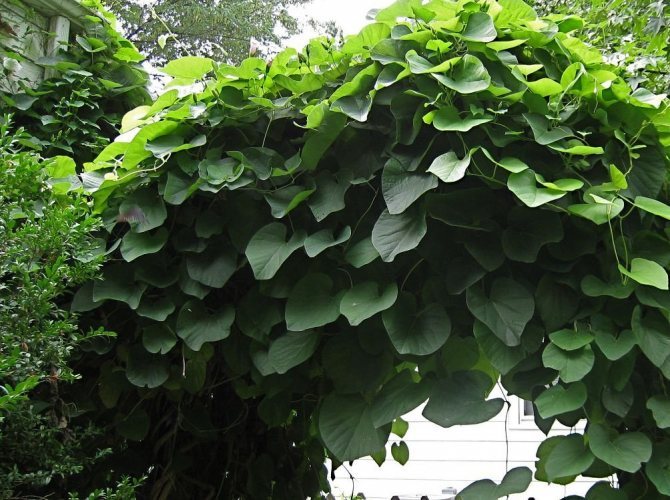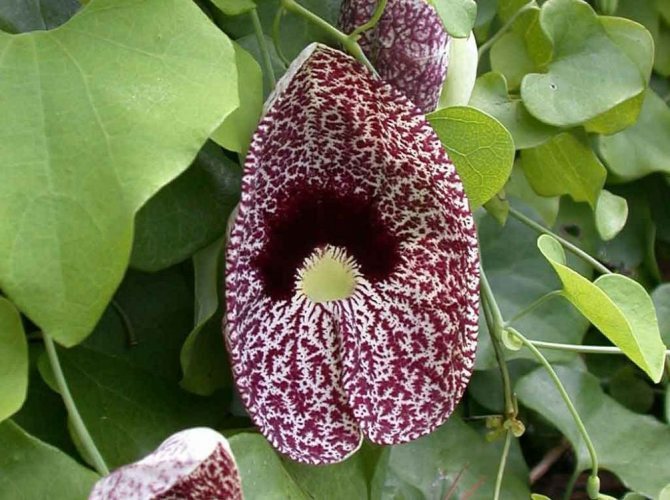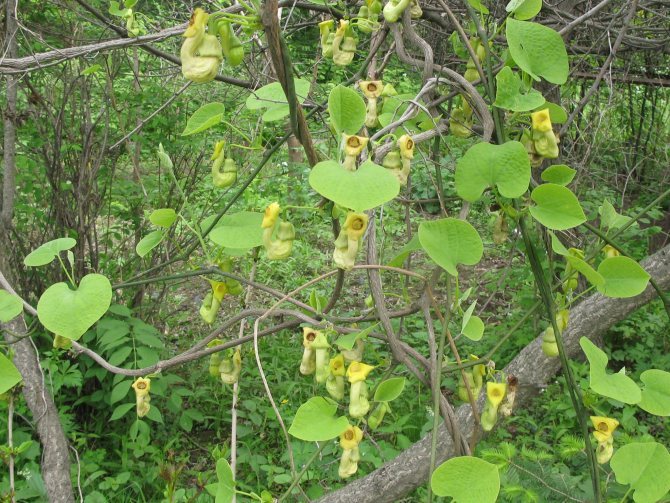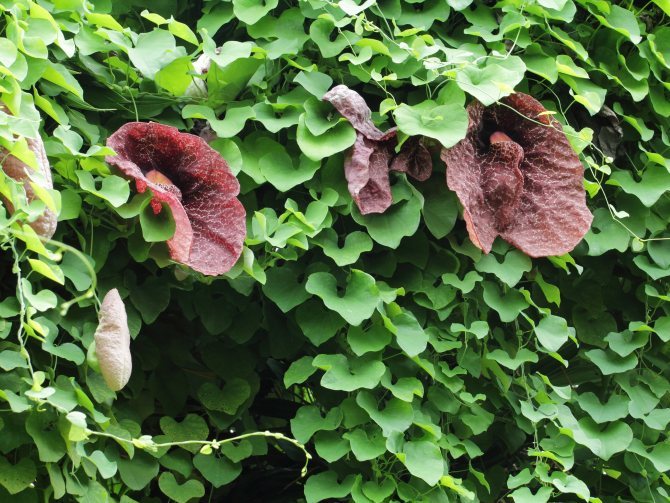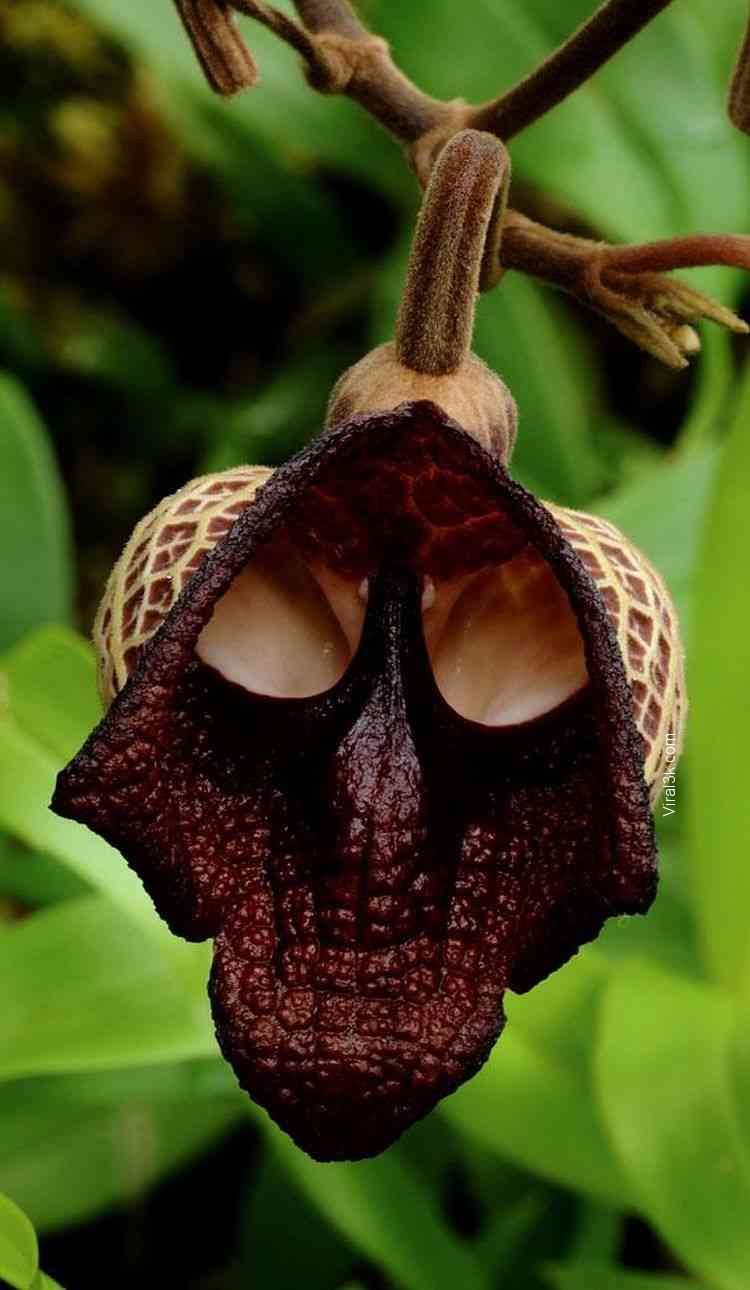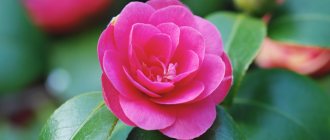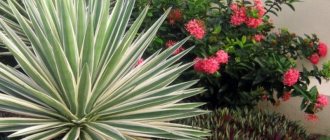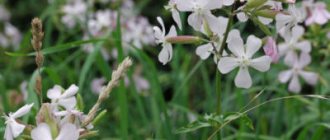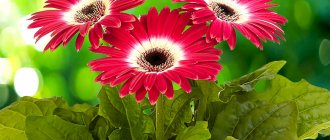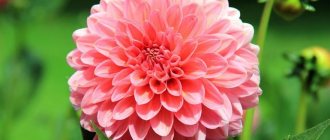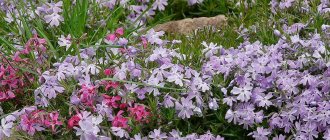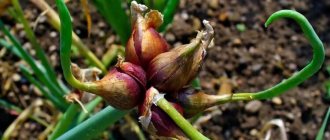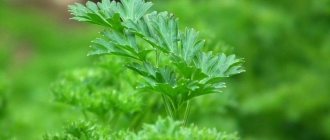Ampel cultures allow you to effectively decorate various surfaces and create unique floristic compositions. Kirkazon or aristolochia are woody and herbaceous vines for landscaping in a personal plot.
One of the best options for landscaping vertical surfaces is Aristolochia - perennial woody and herbaceous vines of the same genus of the Aristolochia family. The genus includes various forms of liana and its cultivation as perennials and annuals. The plant is typical for this family. In total, about 500 varieties of herbaceous perennials are known. Many species are found in tropical zones, some of them in Russia as wild plants. In horticulture, mainly decorative varieties and varieties with original flowering and structure of leaf plates are used. Agrotechnical rules for planting Kirkazon creepers are quite simple - you can read about them in the proposed material.
Look at the types of aristolochia in the photo, which shows the Manchurian, clematis and large-leaved Kirkazon:
Description of the plant

The Kirkazon plant belongs to perennials with a branched network of root cuttings located close to the soil surface. Shoots branch moderately. Their length ranges from 8 to 14 m. At the bottom, the liana-like stems look greyish and stick out in the vertical direction. Young shoots are protected by smooth brown bark. Over time, the shell becomes covered with cracks and acquires a brown color. The top of the vine is pliable, the hairy stems bend freely.
The leaf blades of Kirkazon are decorative. The shape of the leaf resembles a heart or an arrow. The foliage color is represented by various shades of the green palette. The reverse side contains a layer of short nap. The successive plates grow in length by 5-30 cm. They are attached to the stem with the help of elongated, like arcs, petioles. An adult vine is a dense green carpet if it receives the necessary light during the day.
Aristolochia blooms in late spring. The buds stay on the shoots for no more than 20 days. Some species bloom much later. Flowers are collected in groups of 8 or popped out one by one. The tubules of the inflorescences look like a water lily or a gramophone. Insects often penetrate into the core. Vine pollination is achieved at the expense of flies, since the flowering buds are characterized by a repulsive putrefactive smell. There are red, red-brown or yellow inflorescences. Vine bushes bloom from the age of five.
In place of pollinated tubular inflorescences, drooping seed pods appear, where small grains are stored. When the capsule is fully ripe, the thin walls break and the seeds fly away from the planting site.
Recipes for home use
Kirkazon is used in the form of tinctures, infusions, decoctions, ointments:
- Tincture. Pour half a teaspoon into 100 g of vodka, leave for 1 week in a dark place. Shake occasionally. Squeeze out. Recommended 20 drops 3 times a day. Effective for dropsy, malaria, accelerates wound healing, cleanses them.
- Infusion. Pour 2 spoons with a glass of water. Filter after 5 hours. Drink 2 tablespoons after each meal.
- Decoction for external use. 1 tsp dry root (you can replace 2 tbsp.l of dried herbs) chop, pour a glass of boiling water, keep on fire for half an hour. Use for compresses and rinses.
- Ointment. Grind 100 g of Kirkazon, pour into a half-liter jar, pour pork fat without salt. Do not fill the jar completely, leave the jar free for 2 fingers. Hold in a water bath for 2 hours. Keep refrigerated. Apply morning and evening.
In addition, the following recipes are used:
- 1 tsp is crushed, poured with 2 cups of boiled cold water in a thermos. Leave it overnight. In the morning, squeeze, filter, add enough water to bring to the original amount. Drink 1/4 cup half an hour after eating for gout, muscle pain, tuberculosis, other pulmonary diseases, hypertension, dropsy.
- Take half a teaspoon of Kirkazon in a glass of water, keep it on low heat for 20 minutes. They are filtering. Take 1 spoon 3-4 times a day. Effective for the treatment of coughs, colds, shortness of breath, indigestion, headaches, migraines.
- 1 tsp of herbs is poured into 250 ml of chilled boiled water in a thermos. Leave it overnight. Take 1 tsp 4-5 times daily before meals. The dose is gradually increased to 1 tbsp. l. Drink for insomnia, fatigue, neurosis, stuttering, nervous exhaustion, vascular dystonia.
Kirkazon is added to baths for psoriasis, scrofula, abscesses, mastitis. Pour 2 tablespoons into a glass of boiling water, keep on low heat for 15 minutes. They are filtering. Prepare a bath with a temperature of 35-38o, pour in the finished infusion. The duration of the bath is 10-20 minutes.
Growing Kirkazon
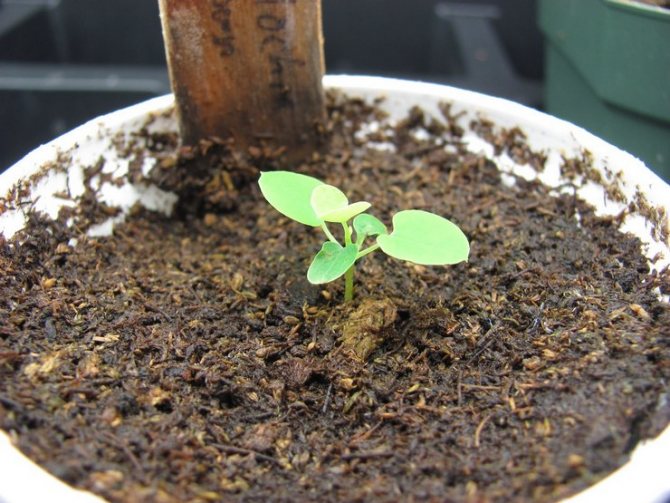

We'll have to work hard to grow Kirkazon. Gardeners recommend using seed or vegetative propagation. In the latter case, cuttings are taken as planting material or cuttings are harvested. A less time-consuming method is considered to be the method of rooting layers. The creeper shoot is bent to the ground and slightly pressed down. The area of the bark at the point of contact with the soil is peeled off a little. Rooting occurs very quickly. Only biennial plants are suitable for reproduction.
In the south, gardeners successfully use the cuttings method. Before the buds begin to bloom, shoots are harvested and their soil is rooted. Planting cuttings can also be done in the fall. To accelerate the development of roots, the sections are moistened in "Kornevin". Cuttings are dipped into wet sand or fertile wet substrate.
Planted cuttings are regularly watered, covered with foil and protected for the winter. The site is covered with peat mulch. With the arrival of spring, young Kirkazones are transplanted to a new place.
Certain types of aristolochia are capable of sprouting numerous processes that are perfect for breeding a bush. Root shoots need the same care as an adult vine.
Seed sowing is performed in September-October. Well-ripe grains are poured into the holes to a depth of no more than 3 cm, a small layer of earth and compost is poured on top. The emergence of seedlings is expected at the end of April. During the first year of life, the plant increases in length by 20-50 cm. Seedlings are transplanted only when they reach two or three years of age.
Reproduction
You can use seeds for propagation. But in open conditions, only a small number of seeds germinate. Growing at home is an alternative. For this, a container and soil are prepared. Seeds are sown in moist soil and covered with foil. After the seedlings grow, they are seated in separate pots. As soon as the plants take root, gain strength and power, they can be planted in open ground. This method is not popular among experienced florists.
The easiest way to propagate is by cuttings. Before flowering or after, cuttings are cut off and planted in the ground. Cover future plants with a cut bottle for warmth. After the cuttings have taken root, the bottle should be removed. Care for young plants is the same as for adults.
You can try to propagate the plant using layering. The method is simple. The plant is bent down to the ground. Sprinkle part of the plant with moist earth. When this part is rooted, it is necessary to cut it off from the main plant. This method can only be used in the spring.
Planting Kirkazon
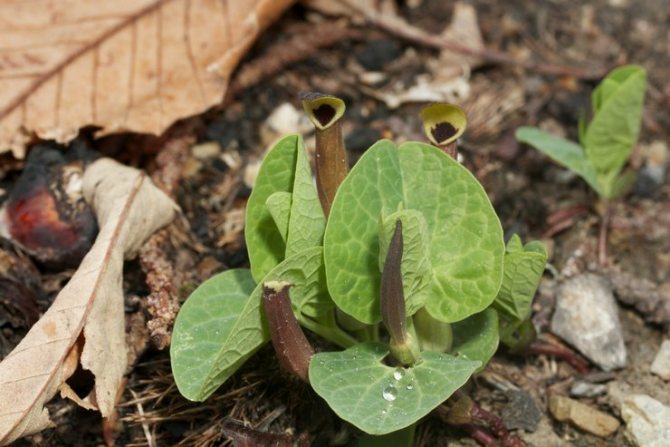

Planting Kirkazon is best done in well-drained and nutritious soil. Sparse solid soils have a worse effect on the development of the plant. A hole dug to a depth of at least half a meter is covered with pebbles, compost mixed with sand and peat is poured on top. The last layer is taken under the sod land. The acidic environment oppresses the vines. In this regard, it is not recommended to dilute the substrate with coniferous residues. The compost is harvested only from broad-leaved sawn timber.
It is required to observe the interval between seedlings from 0.8 to 1 m, since the shoots tend to grow. Kirkazon tolerates transplants easier if the roots are shortened by a third.
Recipes
Application methods:
- 1 / 2-1 / 3 teaspoon of dry leaves of kirkazon pour 1 cup boiling water, boil for 15 minutes, cool, drain. Take 1 tablespoon 3-4 times a day.
- Pour 1 / 4-1 / 2 teaspoon of Kirkazon herb with 1 cup of boiled water, leave for 8 hours, drain. Take 1/4 cup 2-3 times a day.
- 1/2 teaspoon of dry herb kirkazon pour 100 g of vodka, insist for a week, strain. Take 20 drops 3-4 times a day.
- Decoction for external use: 2 tablespoons; Pour the chopped root with 2 cups of water, bring to a boil, boil for half an hour, strain. Apply for baths. Baths should be done for no longer than 10-20 minutes.
Kirkazon is familiar to many lovers of beautiful gardens and landscape design. He immediately catches the eye with his exotic beauty. But this plant can be successfully used in folk medicine to cure many serious diseases.
Kirkazon care
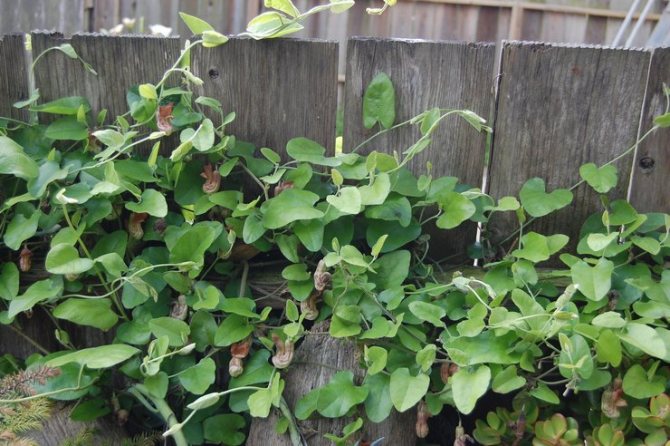

Caring for the cultivated species of Kirkazon is quite simple. The grass grows well in open, semi-shaded areas, far from drafts. In the light, flowering at the bushes is less common, the foliage looks sluggish and unattractive. The optimal location of the plant near water bodies and along the coastline. Humidity and regular watering are the main requirements for caring for Kirkazon. The crown is also sprayed with water. In a humid environment, the bushes fully develop. The damp warm weather turns them into a thick grassy carpet that covers the walls of houses and fences like a vine.
Loosening and weeding the site will get rid of weeds and prevent the formation of a crust on the soil surface, and the root system will be saturated with oxygen. The soil is loosened to a depth of no more than 5 cm. These measures are sufficient to maintain the health of the plant.
In the summer months, the roots of aristolochia are fertilized with organic solutions. At the same time, watering is carried out to protect the roots from burns.
In one season, vine shoots grow about 25 cm in length. Therefore, the perennial must be cut off in time and dry stems, leaves and unnecessary shoots must be removed, or the support will break under the weight of the vegetation. Varieties that do not tolerate cold, and young bushes are wrapped up for the winter. The soil area near the root growth is covered with reripe foliage and spruce branches. The supports are removed, and the shoots are wrapped in protective material.
If the plantings are too thick, or the irrigation regime is violated, Kirkazon can get sick with powdery mildew or rot. Sick bushes are treated with fungicidal preparations and the affected areas are cut out. The spider mite is the most dangerous parasite. Insects hide in leaf axils, sucking out cell sap. With regular spraying of vines, the risk of infection is significantly reduced. Insecticidal solutions are used in pest control.
Watering aristolochia
The composition of the substrate is not particularly important, but it should be nutritious, loose and humic, and also have a large structure. These vines love moisture and grow well in lowlands and near water bodies.
This crop treats droughts poorly and needs watering if it does not grow near a reservoir. Watering, 10 liters of water are used per individual. Houseplants are also often watered to keep the soil slightly damp. In winter, watering is reduced if the temperature of the content also decreases.
After watering, the soil is loosened and weeds are removed, but note that the root system of aristolochia lies close to the surface, therefore, during weeding, it is impossible to go deeper into the soil further than 5-7 cm.
At the beginning and middle of the growing season, complex mineral fertilizer should be applied in the dose specified in the instructions.


Types and varieties of Kirkazon with a photo
Breeders have about two hundred species of kirkazon. On the territory of the Russian Federation, it is customary to grow 7 species. Let's consider the most popular ones.
Common Kirkazon (Aristolochia clematitis)
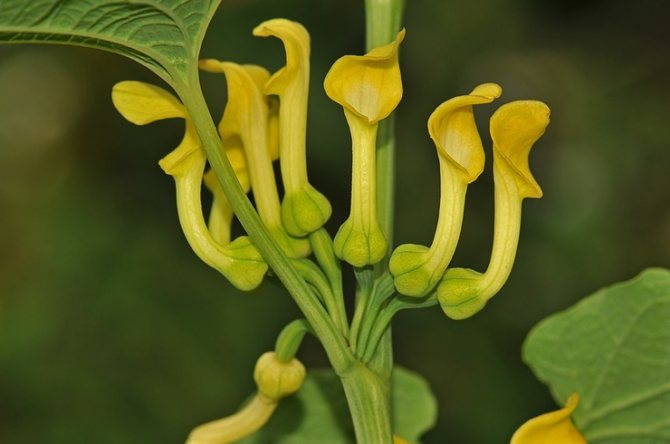

A tall herbaceous vine that grows up to 15 m in length. The rough ovoid leaves have a matte surface. The tips of the leaves are rounded. Yellow jug flowers are born at the end of May. After a month and a half, fruit ripening is observed. These are ball-shaped seed pods resembling small pumpkins.
Large-leaved Kirkazon (Aristolochia macrophylla)
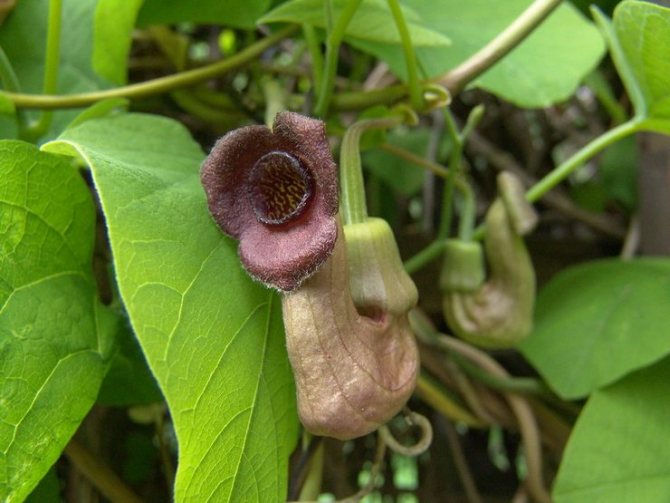

Another herbaceous vine with smooth bog-colored bark. As they mature, the bark cracks and becomes brownish in tone. The diameter of the bright green leaves does not exceed 30 cm. Individual bushes may contain leaves of different shades, which gives the vine a mosaic and special appeal. With the arrival of autumn, the foliage falls even green. This species blooms in early summer. From the sinuses, yellow tubules of inflorescences are formed, resembling water lilies. Upon completion of the pollination process, seed boxes ripen. If there are few natural pollinators in the area where the liana is grown, Aristolochia large-leaved will almost stop bearing fruit.
Manchurian Kirkazon (Aristolochia manshuriensis)
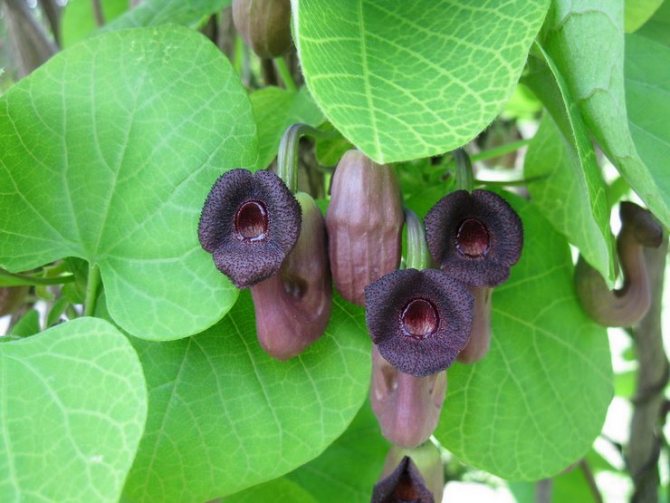

It is a lily vine covered with wide leaves of rich green color. The leaf blades exude a fragrant camphor smell. The size of one leaf is approximately 20-30 cm. The species blooms in May. The inflorescences are located in the axils. The color of the tubes is cream. At the end of the season, the leaves turn yellow and fall off.
Felt Kirkazon (Aristolochia tomentosa)
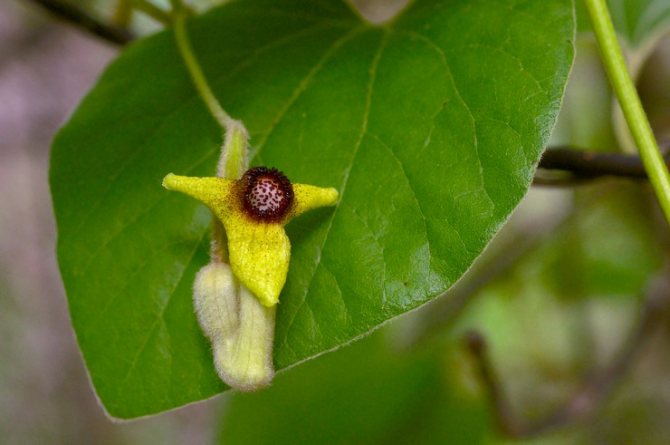

The height of the perennial does not exceed 10 m. Curly stems and greenery contain a layer of felt on the surface. The plastics are pale green without a glossy sheen. The foliage is ovoid, about 16 cm in diameter. Yellow flowers with folded petals open their heads in June.
Kirkazon graceful (Aristolochia elegans)
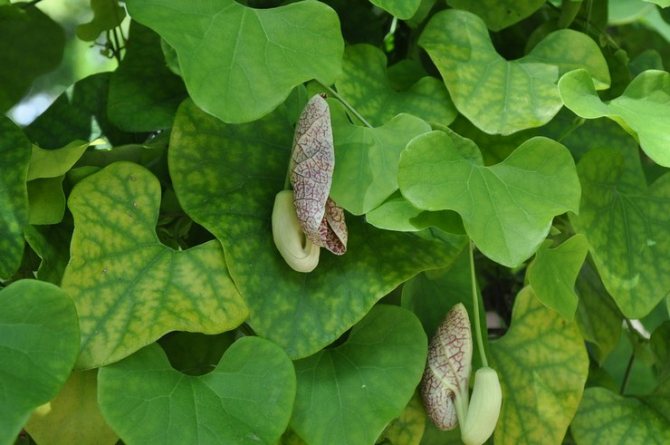

A beautiful slender liana with large inflorescences, which are placed on the stem singly or in groups of 6. The tubules have wrinkled edges. Their size ranges from 8-10 cm. The outer side of the corolla is creamy, and the inner mesh of the veins has a reddish bloom. The flowering of the vine begins in the middle of summer and continues until the first cold snap.
The power of luxurious greenery of the strictest of vines
We have a controversial attitude towards this vine. Kirkazon is endowed with almost miraculous medicinal properties and is used in alternative medicine, the plant is often regarded as purely useful and does not pay attention to its beauty. Since ancient times, this vine has been considered the patron saint of birth, but today it is glorified as a universal healer. Even Aristolochia got its name in honor of the Greek "aristos" (the best) and "lochein" (birth). But it is precisely the decorative talents of the Aristolochians that are the most obvious, valuable and vivid. And the beauty of this giant creeper is easy to appreciate from a young age.
Kirkazon, or aristolochia (Aristolochia) is a genus of deciduous, woody, very large creeping vines, often exceeding 10 m in height. Their main advantages are tiled crown, fast growth and huge size. For all, without exception, aristolochia are characterized by large, whole-edged leaves. The shape of the leaf blades is most often heart-shaped, and the color is deep light green, fresh, bright, successfully contrasting with the classic garden greens.
The main feature of Kirkazon is not even the size of the leaves, but their location. They are placed on top of each other like tiles, creating amazing ornaments reminiscent of brickwork. But the most original feature of aristolochia is rightfully considered the original inflorescences. The strongly curved tube, strikingly wide bend and outlandish color give the impression of some kind of tropical exotic. True, due to the size and power of the foliage, in order to see beautiful branches and fruits, you need to try: they are most often hidden, hidden in the crown. Flowers bloom for 5-25 days, flowering begins in different aristolochia at the age of 5 to 8 years. And the elongated fruit pods on these vines look very attractive.
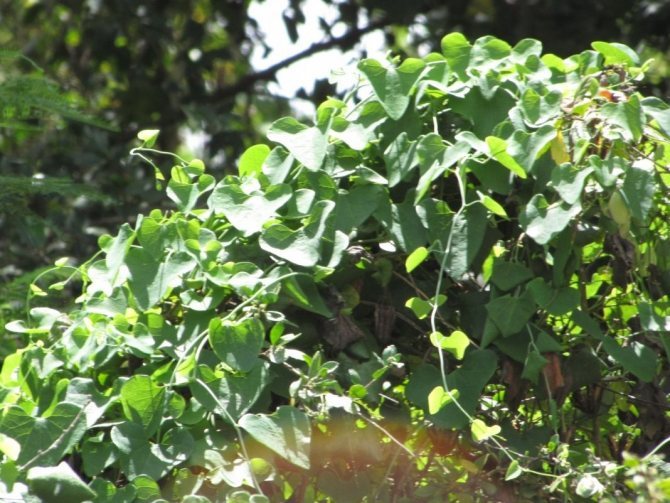

Coastal Kirkazon (Aristolochia littoralis).
Kirkazon in landscape design
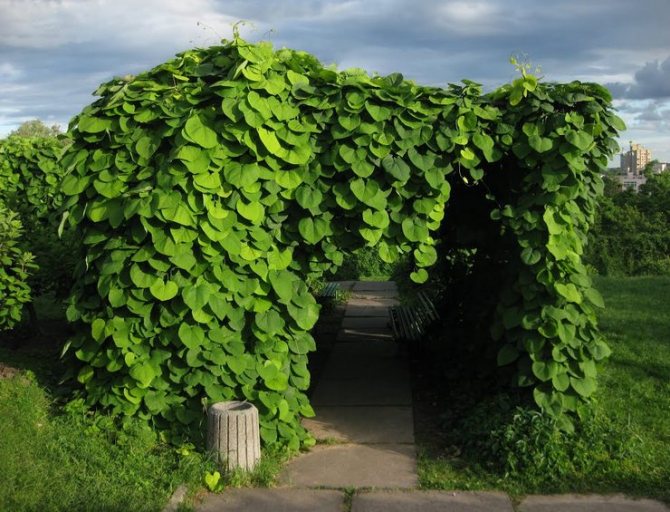

Under the dense cascade of vines, it is easy to hide any unattractive extension or frayed fence. The wide leaves of kirkazon allow you to create real plant arches and decorate the roof of the gazebo. In the dense shade cast by a perennial, it is comfortable to take refuge on a hot sunny day. The lifespan of the febrile herb reaches about 30 years. The vine grows in mass every year.
Recipes
- Herb decoction: one teaspoon of dry herb is poured with a glass of boiling water, heated in a water bath for five minutes, then insisted in a thermos for half an hour, filtered. Take after meals, three times a day, a tablespoon.
- Decoction of roots: pour one tablespoon of crushed dry roots with one liter of boiling water, put on a small fire and cook for ten minutes. After that, they insist and filter for half an hour. Take two or three glasses a day for diseases of the digestive system, rheumatism, general weakness, as a diaphoretic and diuretic.
Botanical name:
ARISTOLOCHIA CLEMATITIS L. - ORANGE KIRKAZON FAMILY ARISTOLOCHIACEAE - KIRKAZON
Popular names: finnik, fever grass
The healing properties of Kirkazon
Vine stems and leaves contain a high amount of beneficial acids, resins, essential oils. Pharmacological preparations based on Kirkazone have anti-inflammatory, analgesic and diaphoretic properties. Herbal infusions and decoctions are often used as folk remedies. They help reduce blood pressure, improve kidney function, and fight various infections. Extracts from the juice of the leaves are applied to the foci of inflammation on the skin, purulent wounds and boils. The use of compression wraps soothes the pain of mastitis.
Despite a number of medicinal properties of Kirkazone, the use of the herb requires care and caution. An excess of the drug in the body or unjustified use entails the development of cancers and problems with the functioning of the liver and kidneys. Overdose may cause allergic skin rashes. Reception of Kirkazon must be coordinated with a doctor.
Garden flowers Perennial flowers
Contraindications
Kirkazon is a poisonous plant! Applying Kirkazon externally, collecting herbs requires great care. Use after the recommendation of the attending specialist, since all Kirkazone herb, including seeds and rhizomes, contains the alkoloid aristoloquine, which destroys the stomach lining, negatively affects blood circulation.
When collecting Kirkazon with bare hands, a burn appears.It is categorically impossible to pick up and even more so to use it inside children. The plant is contraindicated for pregnant women, it is not used for kidney disease, gastritis.



